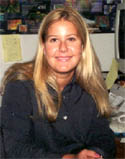I work at the ESRI Olympia regional office as an internal marketing representative and on the Business Partner Team.I have been with ESRI for approximately 8 months.Interestingly enough, it was an accident how I initially got into GIS.While I was a sophomore in school I was working as a nanny and had to try and work out my class schedule with my work schedule (not easy to do at a large University and being a sophomore).So when class registration came around, I tried registering for every Geography class possible and every class was closed except for this GIS class.
What is your background?
After graduating high school from a small town, I went to Seattle to attend the University of Washington.Not many people from my hometown actually left and went for higher education.In the four years that I attended the University, I received my BA in Geography/GIS degree with a minor in Urban Planning.In addition, I was fortunate to land an internship at the City of Kirkland Planning Department.At this internship I worked with an ESRI Business Partner who taught me a lot about GIS and essentially became a role model.To continue my GIS education, I have taken many classes here at our office.
Would you recommend GIS to other women?
Learn as much as you can about the technology but realize that GIS is much more than just software.We always talk about the 5 parts of a GIS - people, data, procedures/analysis, hardware and software.The most important aspect I feel is good people.The successful implementers of GIS understand their own business process and more importantly how GIS fits into (and enhances) those processes.Technology does not change people - people change people.
It is never to late for a woman to start learning about GIS.Take classes at the local college or simply talk to a GIS professional.Also, ESRI now offers virtual campus classes.This is a self-paced GIS education and training class that you can sign up on through our web site.Virtual Campus allows you to take courses in GIScience, GIS Applications, and GIS technology.In addition, you can meet GIS professionals from around the world.
What is the accomplishment of which you are most proud?
When I look back at all I have accomplished, the one that I am most proud of is graduating from college.I am the first in my family to attend and graduate from college.Also, I am extremely proud to know that I chose an exciting major that has allowed me to start my successful career in GIS.
What does your typical day or week look like?
Half of my day is typically spent communicating with ESRI partners and clients (existing and potential).I am a hub of communication between ESRI marketing representatives, clients, and ESRI business partners.Therefore, I spend a fair amount of time responding to email, distributing RFPs and sales leads to ESRI partners, coordinating meetings and visiting our partners.
The other half of the day is spent supporting the direct marketing representative by preparing quotes for clients, tracking leads, responding to phone calls and emails, running reports and preparing for sales meetings.On the average, I spent around 60 hours at work a week.
Why is GIS an exciting industry in which to participate?
I feel that GIS is starting to find its way into the mainstream.The applications, potential uses, and number of clients of GIS are literally exploding.As GIS embraces the world of intelligent object-oriented databases, object-oriented development environments, and distributed geoprocessing there is no more exciting time to be in this industry than right now! As the Internet has become the vehicle for the spread of technology to the masses, GIS will become an important ''integrative'' and holistic technology to organize the world around us.
What is the most important ''next thing'' that will happen in GIS?
This appears to the year of taking your GIS ''to the field.'' Wireless technologies are opening up many possibilities for new potential GIS applications.Additionally, Application Service Providers (ASP) are getting interested in GIS and there appears to be demand for numerous applications that leverage the power of GIS databases throughout the world.
Before you came to GIS, what did you think your career would be in?
For as long as I can remember, I wanted to be an actress.
Email: swilliams@esri.com
More Women in GIS
 Stephanie Williams
Stephanie Williams